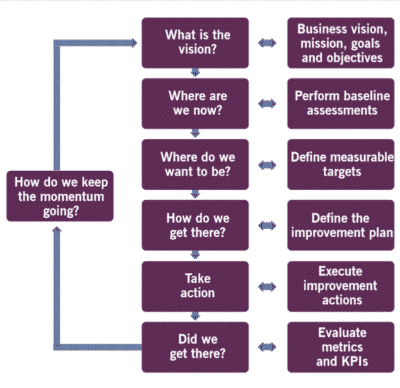| Table of Contents |
|---|
...
| Reference_description_with_linked_URLs_______________________ | Notes______________________________________________________________ |
|---|---|
| m Business Process Solution Design Tools | |
| s Blockchain Opportunity Assessment - BOA | |
| m Consulting Process | |
| Modern Platform ODP supports VCE , DANVCE > Value Chain Economies are virtual economic communities | |
| Design Tools | |
| m REST API design and tools | |
| m REST | |
| m Design Patterns | |
| m Design Engineering Themes | |
| api-service-mgt-v1 gdoc | |
| api-service-mgt-v1.docx | |
| https://itsmacademy.com/content/WHATIS_The_ITIL_Maturity_Model.pdf | |
| https://www.infopulse.com/blog/itsm-maturity-assessment-checklist | |
...
- Establish Metrics: Define what constitutes maturity for your microservices, considering aspects like reliability, scalability, resilience, etc.
- Automated Testing and Monitoring: Use automated tools to continuously monitor and test your microservices, providing real-time feedback on their performance and maturity.
- Service-Level Objectives (SLOs) and Service-Level Indicators (SLIs): SLOs define the level of service you aim to provide, and SLIs are the metrics that measure your actual performance against these objectives.
- Incident Response and Postmortem Analysis: When something goes wrong, have a plan to fix it quickly and then conduct a postmortem analysis to learn from it and improve the maturity of the service.
- Regular Reviews: Regularly review the maturity of your services to identify trends, pinpoint areas for improvement, and track progress over time.
ITIL 4 Summary
ITIL SVS - Service Value System - Foundation for Service Management
https://www.owlpoint.com/itil-4/itil-service-value-system/
Principles
The guiding principles helps an organization’s decision making by ensuring there is a shared understanding and common approach to service management across the organization. Each of the guiding principles can be used to evaluate whether an approach or decision meets the fundamentals of the organizations goals and helps sets the organization’s behaviors and culture.
Governance
Governance ensures that the actions of the organization are aligned properly with the strategic direction and goals established by the sponsor groups or governing bodies. It is governance that ensures that value is actually achieved, not just talked about as a target.
Service Value Chain
The Service Value Chain is an operating model for the creation, delivery, and continual improvement of services. The service value chain represents a set of key activities that leverage various practices to form different value streams. These value streams can be adapted for different types of organizations, including those that have distributed IT versus a centralized IT.
Practices
Practices are the evolution of processes and functions from previous versions of ITIL. They are a set of organizational resources, based on the elements of the four dimensions of service management, designed for performing work or accomplishing an objective.
Continual Improvement
Continual Improvement is an ongoing set of organizational activities at all levels that ensure that the organization’s performance continues to meet the evolving objectives of its key stakeholders.
...
Maturity Model vs Maturity Assessment
The ITIL Maturity Model establishes the criteria to achieve each level of maturity of the Service Value System and the capability of each of the 34 ITIL 4 Practices. The ITIL Assessment is a process of evaluating an organization against a specific set of practices and usually the organization’s adoption of a Service Value System using the criteria established by the ITIL Maturity Model.
3 types of Assessments
There are 3 types of assessments that have been defined by AXELOS. They are:
...
CIP - Continuous Improvement Process
BWC defined in. 1985
The purpose of Continual Improvement is to ensure service and products align – and remain aligned – to the Business continuously.
https://www.infopulse.com/blog/itsm-maturity-assessment-checklist
...
https://www.infopulse.com/blog/itsm-maturity-assessment-checklist
4 Signs Your ITSM is Not Mature:
- Your ITSM processes are ad hoc and undocumented.
- Your processes are repeatable but uncoordinated.
- Your ITIL procedures are in place, but not followed.
- You have set practices and SLAs, but not full automation.
How to resolve Level 1 issues:
- Focus on redefining IT service management practices and processes. Each process needs to be aligned with the relevant business context for higher efficiency. Introduce repeatability into all the daily actions and promote the habit of acting according to the set practices.
- Create preliminary Standard Operating Procedures (SOPs). Work with the IT leaders to determine the optimal set of procedures for common tasks and requests. Create the necessary documentation and consider training to build up the lacking IT service management skills.
- Start building a business case for automation. Based on the defined processes and SOPs, start assessing IT service management software vendors that could provide toolkits for automation. JIRA service desk is a basic solution, popular with technical teams. ServiceNow is a more comprehensive, enterprise-grade platform.
How to resolve Level 2 issues:
- Resolve IT isolation. On an inner level, focus on further process formalization, documentation, and automation. Commit to creating a more diverse range of resources and SOPs every individual can refer to. Set clear communication policies to promote a timely escalation of issues and increase collaboration between individuals. Start involving more business stakeholders to reduce the confusion around priorities, requirements, and overall strategic direction.
- Procedure standardization. Continue your efforts of consolidating redundant processes, adding automation, and increasing the levels of standardization across all repeatable procedures. ITSM software offers a wide range of benefits to help standardize your processes. It can be used to centralize and automate repetitive tasks, reduce errors, and improve efficiency.
- Adopt tiered support/service desk. To improve service level consistency, start breaking down your ITSM center into tiers to “filter” different issues by type, priority, and complexity. Introduce automation (self-service) for Tier 0 issue resolution and map out proper escalation procedures for more complex ones. Ensure that each Tier is adequately staffed, and every specialist has sufficient access, knowledge, and tools for resolving their set of tasks. Consider an external IT infrastructure management service provider if you lack in-house resources.
How to resolve Level 3 issues:
- Address cultural resistance. Work further with individuals to encourage the adoption of the set policies. Gather feedback for improvements and promote further knowledge sharing practices to speed up the adoption of new ITIL procedures. Address issues both at the grassroots and at management levels.
- Adopt integrated IT service management solutions. IT service management tools provide real-time visibility into the performance of an organization’s applications and devices. To ensure consistency and higher levels of coordination of all IT management and maintenance activities, address multi-capabilities vendors that provide consolidated visibility into different functions and assets, as well as enable centralized monitoring of tasks execution.
How to resolve Level 4 issues:
- Introduce a greater extent of automation: At this point, your company needs to focus on optimization to improve the team’s performance, reduce execution times, and improve customer services. Robotic process automation (RPA) solutions for ITSM process automation are one option to consider. ML-powered predictive infrastructure monitoring systems and intelligent ticket routing engines are another area of interest for ITSM leaders. In 2022, improving the team's productivity through the use of automation solutions was named a top priority for 57% of organizations.
Potential Value Opportunities
...




